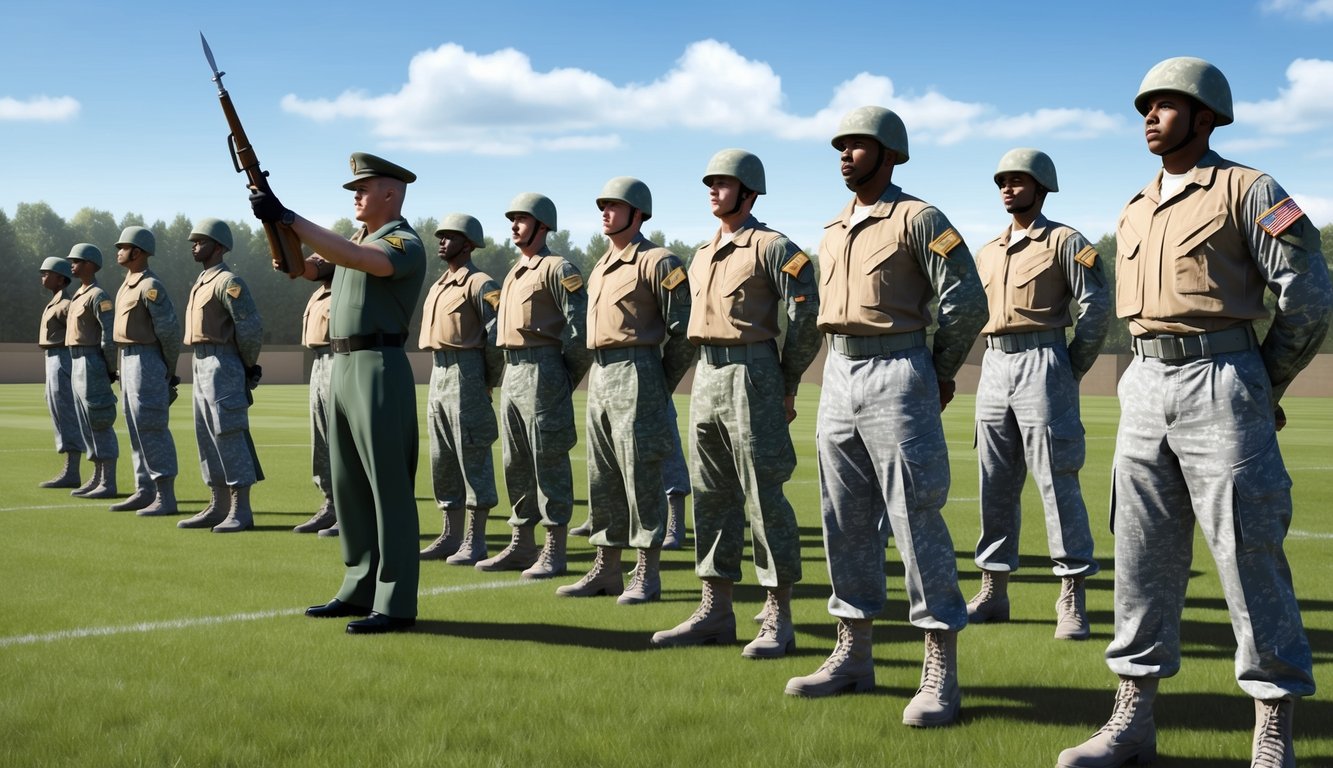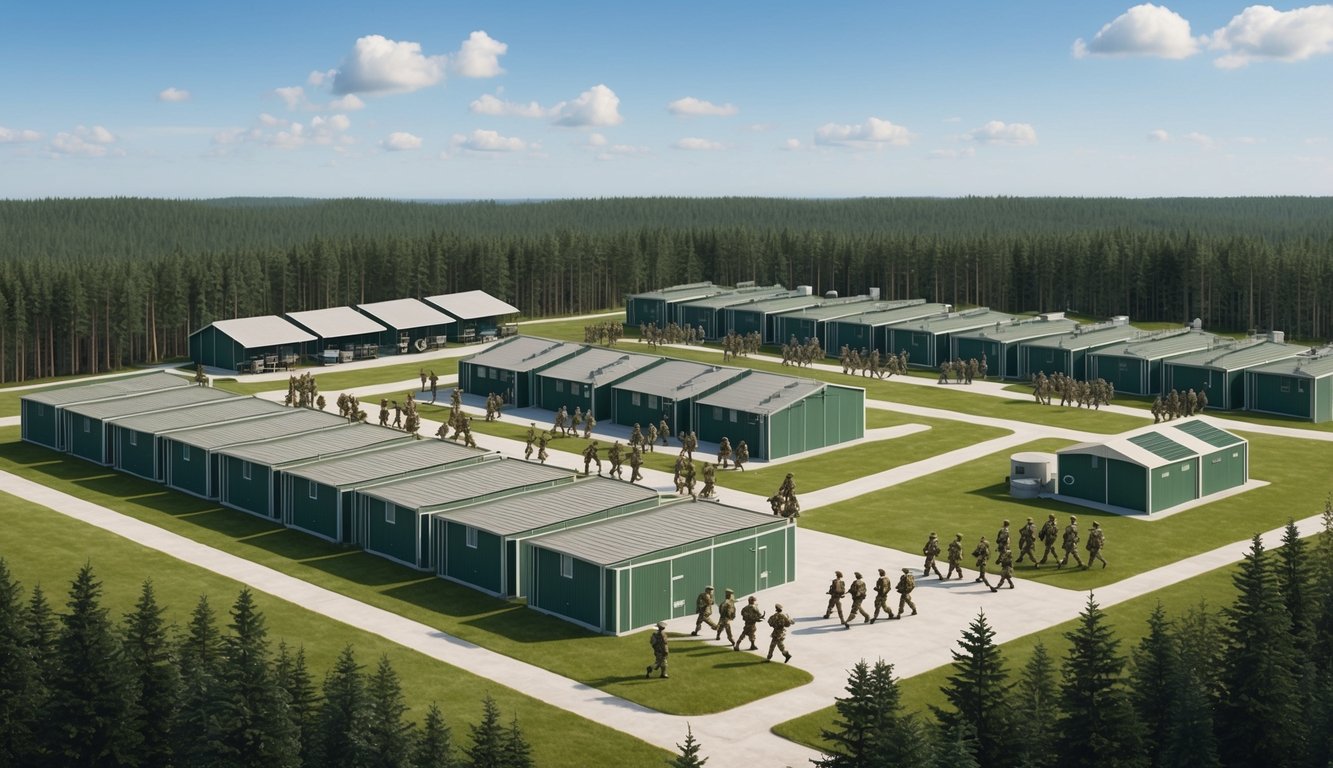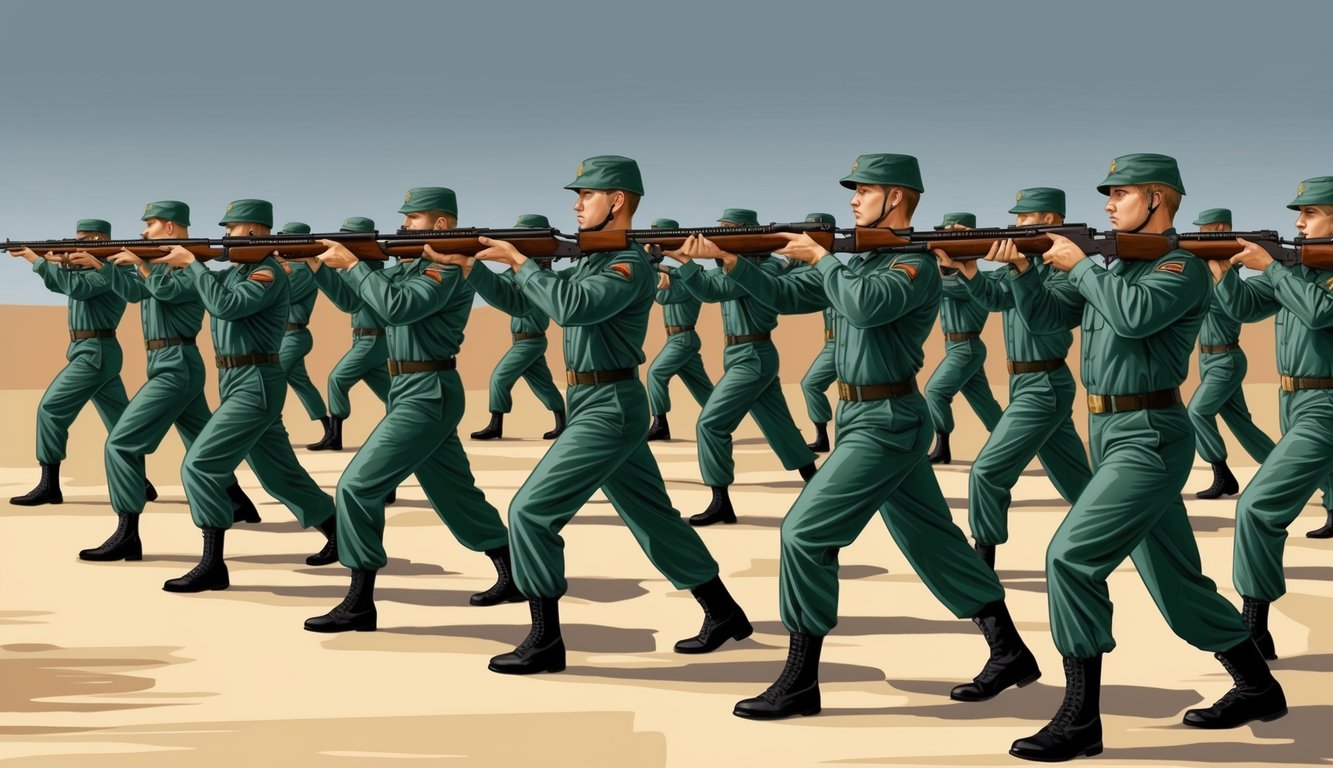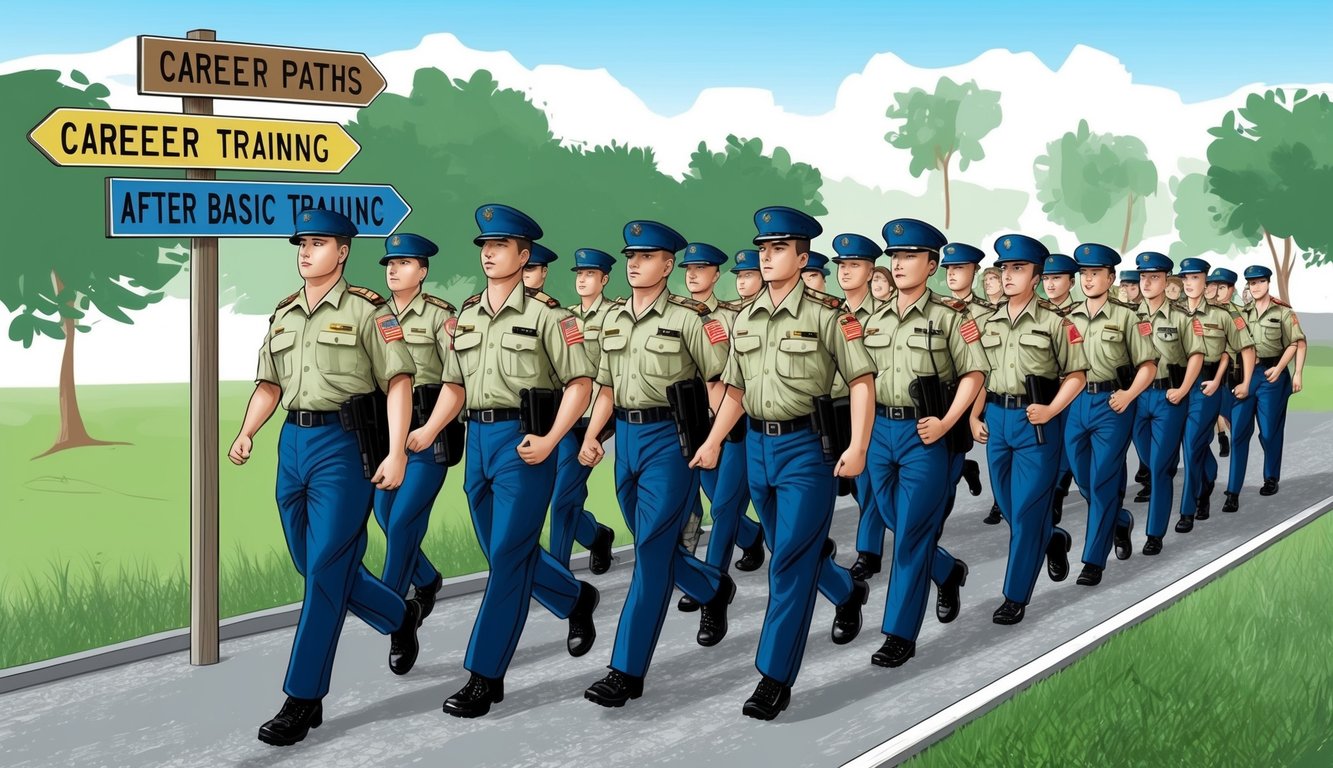Thinking about joining the Army in 2024? You’re in for an exciting journey that starts with basic combat training. This crucial phase transforms civilians into soldiers, equipping you with essential skills and instilling core Army values. Basic training start dates for 2024 are spread throughout the year, with new cycles typically beginning every few weeks.
As you prepare for this life-changing experience, it’s important to understand what lies ahead. Basic training lasts 10 weeks and covers everything from physical fitness and weapons handling to teamwork and discipline. You’ll face challenges that push you to your limits, but the sense of accomplishment you’ll feel at graduation is unparalleled.
Whether you’re heading to Fort Jackson, Fort Leonard Wood, or another training location, your journey begins the moment you step off the bus. From day one, you’ll be immersed in the Army lifestyle, learning what it means to be part of something bigger than yourself. Get ready to embark on a transformative experience that will shape your future and serve as the foundation for your military career.
Key Takeaways
- Basic training start dates occur throughout 2024, offering flexibility for new recruits
- The 10-week program covers essential soldier skills and instills Army values
- Graduation marks a significant milestone in your journey to becoming a U.S. Army soldier
Understanding Army Basic Training
Army Basic Training transforms civilians into soldiers through rigorous physical and mental challenges. You’ll learn essential military skills, discipline, and core values during this intensive program.
What Is Basic Combat Training?
Basic Combat Training (BCT) is your 10-week introduction to Army life. You’ll develop physical fitness, learn military customs, and acquire combat skills. BCT pushes you to your limits, building strength and resilience.
The training takes place at various locations across the U.S. You’ll live in barracks with other recruits, following a strict daily schedule. Early mornings, intense workouts, and classroom instruction fill your days.
You’ll learn to handle weapons, navigate terrain, and work as a team. BCT also teaches you first aid, communication skills, and military law.
The Core Values and Discipline in Basic Training
Discipline is the foundation of Army life. You’ll learn to follow orders promptly and precisely. Attention to detail becomes second nature as you master tasks like making your bed to exact specifications.
The Army’s core values guide everything you do:
- Loyalty
- Duty
- Respect
- Selfless Service
- Honor
- Integrity
- Personal Courage
These values shape your character and decision-making. You’ll be tested on them throughout BCT.
Drill sergeants enforce strict standards. Their tough approach helps you develop mental toughness and self-discipline.
Overview of Army Basic Training Phases
BCT consists of three main phases:
Red Phase: This initial stage focuses on physical fitness and basic military skills. You’ll learn drill and ceremony, Army traditions, and how to wear your uniform properly.
White Phase: Here, you’ll dive deeper into combat skills. Marksmanship training, tactical movements, and field exercises become your daily routine. You’ll also tackle obstacle courses and build confidence.
Blue Phase: The final phase puts your skills to the test. You’ll face more complex field training exercises and qualify with your weapon. Teamwork becomes crucial as you prepare for graduation.
Each phase builds on the previous one, gradually transforming you into a soldier. By the end, you’ll be ready to serve in the Army with pride and confidence.
2024 Basic Training Calendar

The 2024 Army Basic Training calendar outlines key dates and events for new recruits. It covers the enlistment process, training milestones, and graduation ceremonies throughout the year.
Key Dates and Events
Army Basic Training typically begins in late April 2024, with additional start dates spread throughout the year. Here are some important dates to keep in mind:
- Classes Begin: Shortly after Martin Luther King Jr. Day
- 500th Night: Varies; check the official Army academic calendar
- Presidents Day: February 19, 2024
- Sandhurst Competition: Usually held in April
- Projects Day: Typically in early May
Remember that specific dates may vary by training location and cycle. It’s best to confirm exact dates with your recruiter or the official Army website.
Enlistment and Reception Process
Your journey starts with the enlistment process. Here’s what you can expect:
- Meet with a recruiter to discuss career options
- Take the ASVAB test
- Complete a physical examination at MEPS
- Choose your MOS and sign your contract
- Receive your ship date to Basic Training
Upon arrival at your training location, you’ll go through reception. This typically lasts 3-5 days and includes:
- Paperwork processing
- Initial uniform and gear issue
- Haircuts and basic orientation
Graduation and Advanced Training
Basic Combat Training (BCT) usually lasts 10 weeks. Your graduation date will depend on your start date. Family and friends are often invited to attend this milestone event.
After BCT, you’ll move on to Advanced Individual Training (AIT) for your specific MOS. AIT length varies:
- Some roles require just a few weeks
- Technical specialties may take several months
- Highly specialized positions could require a year or more
Your total training time, including BCT and AIT, will determine when you’re ready for your first duty assignment. Stay in touch with your chain of command for the most up-to-date information on your training timeline.
Training Locations and Schedules

The U.S. Army conducts basic training at several posts across the country. Each location follows a structured schedule to transform civilians into soldiers over 10 weeks.
Fort Jackson and Other Training Posts
Fort Jackson in South Carolina is the largest basic training center, processing over 50% of all new recruits. Other key locations include Fort Leonard Wood in Missouri, Fort Sill in Oklahoma, and Fort Moore (formerly Fort Benning) in Georgia.
Each post specializes in certain training areas. Fort Jackson focuses on support roles, while Fort Moore handles infantry and armor training. Fort Leonard Wood trains military police and engineers. Fort Sill specializes in field artillery.
You’ll be assigned to a post based on your chosen Military Occupational Specialty (MOS) and available space. The Army aims to distribute recruits evenly across locations.
Training Schedule by Post
While the core 10-week schedule is similar across posts, there are some variations:
- Fort Jackson: Emphasizes physical fitness early on
- Fort Moore: Incorporates more field exercises
- Fort Leonard Wood: Includes specialized engineering tasks
- Fort Sill: Features artillery-specific training modules
Typically, your day starts at 5:00 AM with physical training. Classes and practical exercises fill most of the day. Evenings involve cleaning, studying, and preparing for the next day.
Weekends may include additional training or limited personal time. The intensity increases as you progress through the weeks.
Life During Basic Training
Basic training transforms civilians into soldiers through intense physical and mental challenges. You’ll experience a structured daily routine, build teamwork skills, and face communication restrictions.
Daily Routine and Teamwork
Your days start early, typically around 5 AM. You’ll quickly learn to work as a team, from morning PT to meals and training exercises. Everything is done together, fostering a strong sense of unity.
Discipline becomes second nature as you follow a strict schedule. You’ll have set times for meals, classes, and physical training. Free time is limited, but you’ll use it wisely to prepare uniforms, clean your living area, or study.
Teamwork is crucial. You’ll rely on fellow recruits during obstacle courses, marches, and combat simulations. This bond helps you push through tough moments and achieve goals you thought impossible.
Physical and Mental Challenges
Physical training is intense. You’ll do push-ups, sit-ups, and run miles daily. The challenges increase as you progress, building your strength and endurance.
Mental toughness is equally important. You’ll face sleep deprivation, stress, and homesickness. Drill sergeants push you to your limits, teaching you to perform under pressure.
You’ll learn combat skills, weapon handling, and first aid. Field exercises test your ability to apply these skills in simulated combat scenarios. It’s exhausting but rewarding as you see yourself improve.
Communication with the Outside World
Contact with family and friends is limited. You’ll have occasional phone privileges, usually on weekends. Letters become a lifeline, offering support and motivation.
Social media and personal devices are off-limits. This helps you focus on training and bond with your fellow soldiers. It’s tough at first, but you’ll adapt quickly.
Care packages are allowed, but contents are restricted. Sharing treats with your platoon can boost morale during challenging times. You’ll learn to appreciate simple comforts and the support from home.
Training Components and Skills Development

Army Basic Training equips you with essential military skills and knowledge. You’ll learn a diverse set of abilities crucial for your role as a soldier.
Warrior Tasks and Battle Drills
Warrior Tasks and Battle Drills form the core of your combat readiness. You’ll master fundamental skills like first aid, communications, and movement techniques. These drills prepare you for real-world scenarios you might face in the field.
You’ll practice reacting to contact, breaking contact, and evacuating casualties. Land navigation becomes second nature as you learn to read maps and use compasses. Individual tactical training hones your ability to move, shoot, and communicate effectively in combat situations.
Marksmanship and Weapons Training
Marksmanship is a crucial skill you’ll develop during Basic Training. You’ll become proficient with the M16 rifle, spending hours at the firing range. Proper weapon handling, maintenance, and safety procedures are drilled into you.
You’ll also get hands-on experience with other weapons systems. This includes machine guns, grenade launchers, and hand grenades. You’ll learn how to identify and react to various types of mines and unexploded ordnance.
Training on these weapons systems isn’t just about shooting. It’s about understanding their tactical applications and limitations in combat scenarios.
Field Training and Survival Skills
Field Training Exercises (FTX) put your new skills to the test in realistic scenarios. You’ll spend days in the field, living out of your rucksack and applying everything you’ve learned.
During these exercises, you’ll practice building shelters, purifying water, and finding food. Land navigation skills are put to use as you navigate unfamiliar terrain. You’ll also learn basic camouflage and concealment techniques.
Combatives training teaches you hand-to-hand combat skills. This builds your confidence and physical fitness while preparing you for close-quarters situations.
Preparing for Basic Training
Getting ready for Army Basic Training takes dedication and planning. You’ll need to focus on physical fitness, gather essential items, and mentally prepare for the challenges ahead.
Physical Fitness and Preparation
Start your fitness routine at least 3-4 months before your report date. Focus on cardio exercises like running, push-ups, and sit-ups. Aim to run 2 miles in under 15-16 minutes.
Practice the Army Combat Fitness Test events as well. These include the 3-rep max deadlift, standing power throw, hand-release push-ups, sprint-drag-carry, leg tuck or plank, and 2-mile run.
Gradually increase your workout intensity. Include strength training to build muscle endurance. Stay hydrated and maintain a balanced diet rich in protein and complex carbs.
What to Bring to Basic Training
Pack light – you’ll be issued most items. Bring your valid ID and documents, a small amount of cash, basic toiletries, a watch (simple, no smartwatches), and plain white underwear and socks.
Don’t bring any expensive items, electronics, or civilian clothes (except what you wear). You’ll be given uniforms and gear. Expect to have your hair cut short (for men) or styled to regulation (for women) upon arrival.
Mental Readiness and Expectations
Prepare yourself mentally for a challenging environment. Basic Training tests your discipline and resilience. You can expect early mornings and long days, strict schedules and rules, intense physical training, as well as the confidence course and warrior tower challenges.
Build mental toughness by setting personal goals, practicing stress management techniques, and learning basic military terms and ranks.
Stay positive and remember why you joined. Your drill sergeants will push you to your limits, but their goal is to transform you into a capable soldier.
Career Paths After Basic Training

After completing Army Basic Training, you’ll have numerous career options and paths to explore. Your skills and interests will help shape your military journey.
Branches and Specializations
The Army offers a wide range of career fields. You might consider joining the infantry if you enjoy challenging physical work and tactical operations. Military police roles could suit you if you’re interested in law enforcement and security. Combat engineers tackle construction and demolition tasks, perfect for those who like hands-on problem-solving.
Specialized training is available for each role. You’ll develop leadership skills regardless of your chosen path. Your aptitude tests and preferences will guide you towards the best fit.
Transitioning to Active Duty or Reserves
You have options for how you serve after basic training. Active duty involves full-time service, living on base or wherever you’re stationed. It offers steady pay and benefits, plus rapid skill development.
The Army Reserve or National Guard allow you to serve part-time. You can maintain a civilian career while training one weekend a month and two weeks a year. This path provides flexibility and additional income.
Your choice impacts your day-to-day life significantly. Active duty offers more immediate immersion in military culture, while reserve components let you balance military service with other pursuits.
Frequently Asked Questions
Army basic training start dates and procedures can be confusing for new recruits. These common questions address key details about timing, preparation, and logistics for 2024 basic training.
Can I choose my ship date for basic training?
Yes, you have some flexibility in selecting your ship date. Work with your recruiter to find available dates that fit your schedule. Popular times like summer may have fewer openings, so be prepared with multiple date options.
What is the timeline for Army basic training?
Army basic training lasts 10 weeks and is divided into three phases: Red, White, and Blue. Each phase builds on skills from the previous one. You’ll graduate after successfully completing all phases and passing final tests.
What to bring to army basic training in 2024?
Pack light. Bring essential documents like your ID and Social Security card, as well as a few days’ worth of comfortable clothes and running shoes. The Army will provide uniforms and most other items you’ll need during training.
How often does Army basic training commence throughout the year?
Basic training classes start frequently throughout the year, with new cycles typically beginning every few weeks. The exact schedule varies by training location and current recruitment needs.
What are the graduation dates for Army basic training in 2024?
Graduation dates are set 10 weeks after each class start date. For specific 2024 dates, check with your recruiter or the Army’s official training calendar. Dates may shift slightly based on holidays or other factors.
How do I find out the start dates for basic training at a specific Army base?
To find out the start dates for basic training at a specific Army base, contact your recruiter. They have access to current schedules and can help you find options that match your preferences and qualifications.
